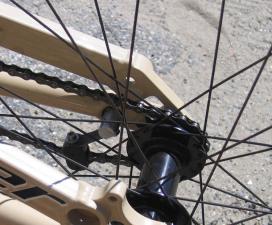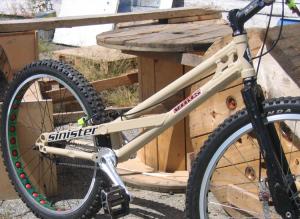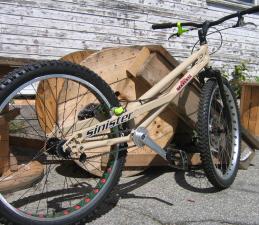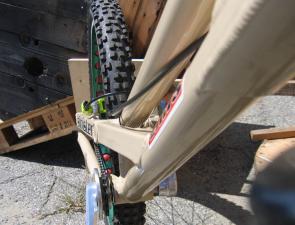
Tim/Trialsin USA
Members-
Posts
175 -
Joined
-
Last visited
Content Type
Profiles
Forums
Gallery
Everything posted by Tim/Trialsin USA
-
a 50cc motorcycle?
-
The actual manufacturer of the BB is the same one of the other brands out there. However, when approaching these companies you get to select the type (material/hardness) of spindle, bearing and such. MOE BBs use harder material spindle and bearings than a similar looking brand.
-
The big boys? You mean the companies that unleash 4 or 5 brands at us that have damn near the same geometry and the advancement is called discovering a new CNC tool? Frank does have experience in trials frame construction....he was building trials frames before anything out of China existed. I know we all like to think trials is somehow different than other types of cycling, but in the end of the day, construction and engineering principles apply across the entirety of cycling. I can assure you the Frank knows vastly more about trials/cycling than the actual people that are doing the welding of most other brands. The square tubes that are the chainstays that extend forward to the downtube are there for a reason, not looks. I made a post (not realizing this thread already existed) under NEWS section. It addresses a number of the issues raised here. I posted there as to try and keep "advertisement" type posts to a minimum in the general discussion forum.
-
At a spindle length of 128mm, no problem with front freewheel. Whatever the bottom bracket you buy, always make sure that the cups will allow for front freewheel as well. There are a number of bottom brackets out there that are actually 73mm spacing, with a spacer behind the drive side cup to get to work in 68mm bottom bracket shell. This can be a problem when using White Industries (widest trials specific freewheel out there) front freewheel set up. Because the cup is spaced 5mm out by the spacer, in effect, you only have a 123mm spindle on the drive side. You see the potential for difficulty here, some (though certainly not all) front freewheel cranks using a thick bashring and/or White Industries freewheel might not clear with a spaced cup BB.
-
A dozen years playing with trials stuff tells me there is no such thing as too beefy for some people.
-
Hey all, Coming in very limited run this fall/winter are frames by Frank The Welder (indcutee into Mountain Bike Hall of Fame this year). Frank is known industry wide for designs thats beauty eminates from principles of engineering. A precision competition machine, not lipstick fashion. Hand built one at a time in USA, these are something more than the copy cats flooding the market currently. Some design features include: 1. Highest grade of 6K series aluminum. There are many grades of aluminum on the market. At this level, there can be only one grade used.......the best. 2. Stiffest frame on the market. The more your frame flexes, the more muscle energy you are wasting. The combination of top quality tubing and intellegent structural design are no accidents here. 3. Simple, clean and durable chain tensioning system. I used to think horizontal dropouts were a good idea, until I had to change a number of peoples tires at events and make sure the disc was re-aligned.....all while in a rush. Vertical dropouts allow for the same alignment, everytime. The current offering of tensioners for vertical dropouts all (for the most part) hang off the derailleur hanger. For the obvious reasons, of smashing etc.., is not satisfactory either. There have been recent additions to the market of rear hubs having the tensioner built in.....this, however straps you to one hub and its exclusiveness of cog. The tensioner mounting system used here on the *** frame is protected and simple and functional....hall mark of a well thought out design in trials. Recognizing that because of different chains/cogs/freewheel combinations not all chain wrap is the same, this tensioner may be set to pull up OR push down on the chain. 4. Derailleur hanger. Personally I think it is silly to design a bike totally wed to having or not having a derailleur hanger. Simple answers are often the best. The derailleur hanger is not mounted behind the axle bolt/QR, thus does not even need to be on the bike (to be smashed) when going single speed. If you would like gears to get you from riding point A to riding point B, simple bolt it on and away you go. OK, OK.......on to the pics
-
Hey all, Have seen this with a number of bikes. The trouble is lack of Q factor (off set of pedal from spindle) in many cranks. Echo, Tensile and Monty do not have that much Q factor. The best bet is a pair of Tryall cranks, they have more offset than others and are lighter too. Also keep in mind, if you are running thread on cog on your cranks, higer Q factor will let you run narrower BB as well giving you a better chain line.
-
Just thought I would throw this out there just in case any of you happen to be visiting eastern US/Canada in a little over a week. Going to be alot of fun!
-
Yes, it was 7 or 8 years ago we did aluminum backed pads. There were a range of issues. 1. If the hole with the rubber grommet was made to fit quite snug to the nipple (little plastic thing sticking out from slave that backing clicks onto), this caused undo stress on the nipple and some broke. 2. If the hole was slack enough fitting to avoid that issue than the problem was that when you put the brakes on while moving the play was enough that it would move.....then slam the backing... thus making more stress on the guide/prongs. 3. If guide/prongs were not smooth there could be issues with the movement of pad. 4. Finally, there is the issue of the TPA. If pads are tested on new well adjusted brakes it does not show itself....but as your pads wear down and you twist the TPA knob....the further the nipple pushes out so pad can hit rim........thus the leverage to break it is greatly increased. For those reasons we decided not to continue the aluminum backed pads. Having said all of that, the breakages were not wide spread....in fact, reletively small....but if you were at competition and one of these things happened that was little consolation. It looks like alot of new pad companies have been wading into the aluminum backed waters, and solved alot of the issues we had. I am glad to see continuous research on this front. Last note on this. Aluminum backed pads do NOTHING for braking power...period. However, it does provide a stiffer feel at the lever......and if that is what works best for you it is an improvement. To date we have yet to find anything but the material itself to improve braking (as it relates to the pad). This was waaay longer note than
-
Yes, they did have funky shaped down tubes in 2004. However, the shape of a tube does not necessarily translate to the same type of technology they are using for new Koxx frames. Drawn, CNC'd, forged or whatever...those terms have been used with great elasticity for many decades....currenty use of those methods is quite different (more advanced as you point out Adam) than previously.
-
The point I was making was not whether Echo used that technology now or not. Please re-read the responce. The statement was that Echo had done it for years, that is the incorrect portion. Unless, of course, anything under 2 years is considers "for years"....then we need to agree upon what version of english interpretation you are using.
-
QUOTE(deanie-b @ Apr 16 2007, 01:03 PM) ←Uh, they have. Uh, no. If you want to compare the word and a really wide definition....OK. If you actually want to compare details.......no. Quotes don't make something so, facts do.
-
uh, no they haven't
-
They are held up my levitation (ah, ha, ha, ha). Geo of V-brake one (ZM2-E) is same as ZM1/ZM2. ZM3 black/white one with disc/hs-33s is exact same geometry as 221Ti (hence looking something akin to them).
-
Ah, ha, ha, ha....gotta love that description! Under those conditions a peice of garden hose fashioned to wood backings using fishing line works pretty well too!.................aaaaaaaaaaaaah, ha, ha, ha!
-
Imported a number of ZHIs (various models) here in North America, no breakages. Have not heard of any rash of breaks anywhere else. Only explanation (though this is a "friend of a friend" story) is that something happened to them in one shipment. As the quality as been on par with anything else.
-
FSA has stopped making 128mm spindle length ISIS BBs.
-
..... VIZ pads and Plazmatic pads are not remotely a similar compound.....
-
Hey all, Cool..... IBC.... installed a few pairs of those for people in the mid '90s! Actually the craftsmanship was pretty nice. The downside was that they took IBC specific pads.... and (at least I) could never get the slave cylinder pods to stay put.... always wanted to rotate, hence twisting the pad into the tire. If they were real cheap I'd buy them just for curiosity....but certainly not more than 20 or 30 pounds (approx US$50). To be honest, don't remember how the power was..... if memory is correct, the Raceline D Maguras (forrunner of HS-33s) was just out...or not quite out yet. Amazing what one can find on the net!
-
Correct, optimally you want the sprockets as close to the BB as possible. Therefore, there is not room to ad sufficient sized collar to that side. BB extractor recesses on the BB don't fill with grime because there is a rotating spindle helping remove a bit of mud. If it were just little holes on the crank cog, I don't see how they are self cleaning in quite the same way as the actual BB. Such little holes on my road bike fill with stuff...... trials bikes can't be less of a magnet for such filth I can't imagine. Again, I agree with alot of you guys ideas.... just we have not found a magic bullet. Maybe we should make a better chainwhip?!
-
All the trials specific ones only have collar on one side. There is only a certain width you can go before the cog would hit BB. And you want the sprockets to be as close to BB as possible for two reasons. 1. It allows for plenty of space for all sorts of chains to fit with no problem. 2. Chain line on trials bikes already sucks, no need to make it worse by pushing the cog further out. There are some cogs that have some thread either side of the sprockets..... however, they are for track bikes and are not optimum (for reasons above as well as many not having enough treads to trust not stripping the threads on cranks). Now, I suppose you could get make it with indentations for BB tool to remove the cog....but those indents are going to fill with dirt, muck and crap.....as well as machining cost (i.e. retail price) goes up.
-
That is the part that faces the bashring/crankarm..... going to be a bit hard to get the vise inbetween.
-
a crappy freewheel tool is no better than a crappy chainwhip, and visa versa. I have had same chainwhip tool for 11 years. Two flats on the inside side of cog. Now we are making the cog wider, hence we need wider BB. A fair bit of metal would have to be there as most vises do not have sharp edges...... enough to make sure it does not jump off the vise.......... and now you need to ad a vise to the collection of tools. I do understand what you all are saying, it would be cool looking to have such a set up....just the gains in practical application are not as many as in theory.
-
Actually you have less leverage with a freewheel or BB tool than with Chainwhip. The further you are out from the center of the spindle, the more leverage you have. Therfore, since the furthest point out from the center on the cog are the teeth........ chainwhip it is. It is easiest to free a cog while the crank is still on the bike. As I said before: 1. remove chain from cog 2. remove driveside pedal 3. put pipe on drive side crank arm 4. rotate crankarm/pipe until it is wedged against the ground (i.e. cranks are locked in forward direction) 5. chainwhip on cog, so that arm of tool is parallel to ground. 6. push....... stand on it if need be (or pipe for more leverage). Leverage is the key. It really doesn't get any easier than that.
-
We considered putting two flats on collar so that a tool similar looking to pedal wrench could be used. But to be honest, we didn't see the point. Creating special tools to get the thing off seemed to be a bit much. Why create new tools that people have to buy if it will not speed the job up? All you have to do is take your drive side pedal off, put a pipe on the arm, rotate until it wedges against the ground.... put chain whip on....... and push down. Cost of pipe?.......... usually free. If a cog is really stuck on there nasty....put a pipe on the chain whip, that will give you more than enough leverage to get it off. Pipe comes in handy for a number of operations on a bike that require a bit less than delicate hand. Over the years I have seen a number of cogs warp and/or break. I have also seen cogs that were machined so poorly the chain did not mesh correctly with the cog. Tim/Plazmatic






